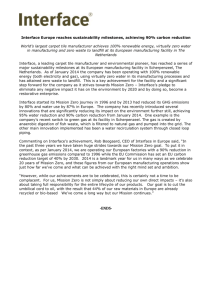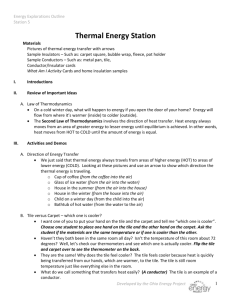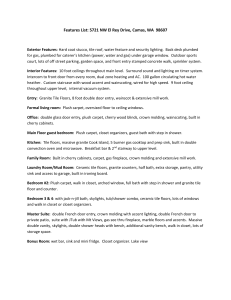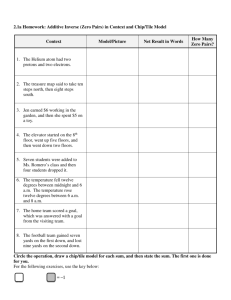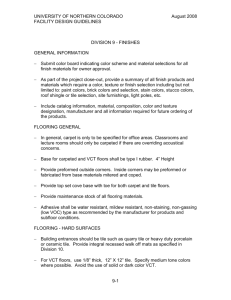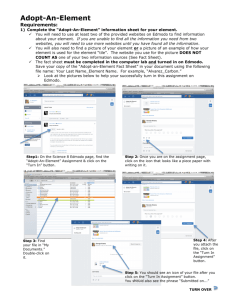Life Cycle Assessment of Carpet Products
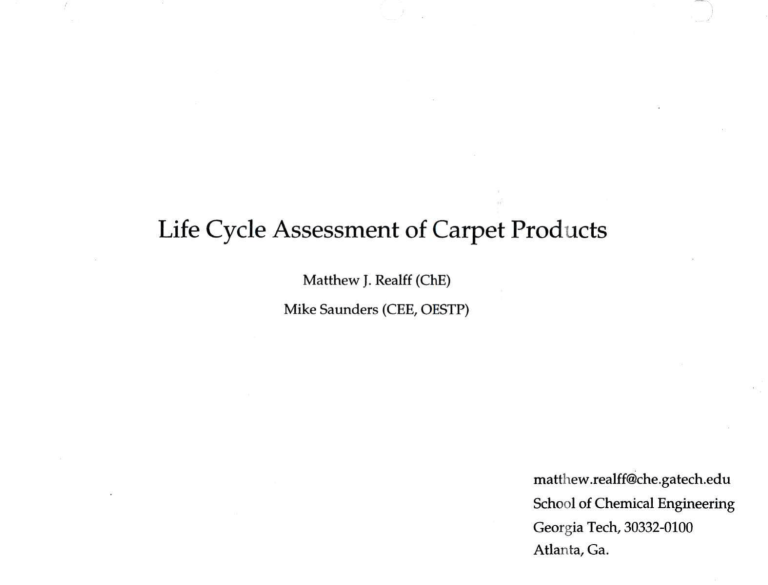
Life Cycle Assessment of Carpet Products
Matthew J. Realff(ChE)
Mike Saunders (CEE, OESTP) matthew.realff@che.gatech.edu
School of Chemical Engineering
Georgia Tech, 30332-0100
Atlanta, Ga.
WHY DO LIFE CYCLE ASSESSMENT?
Identify Opportunities for reduced mass and energy usage.
Identify environmental exposure in overall product cycle
Guide process/product development focus on stages of greatest impact benchmark processes and products
Quantify Environmental Performance Indicators
ISO 14000 Environmental Management
Green Labelling
I
WHAT IS A LIFE CYCLE ?
I
Consecutive and interlinked stages of a product system, from raw material acquisition or generation of natural resources to the final disposal
Environment i ENERGY
Raw Materials
Acquisition
ENERGY
Transportation
IENERGY
Manufacturing
EMISSIONS
T
EMISSIONS
ENERGY
^
T
EMISSIONS
Recycle
EMISSIONS
Waste Disposal
EMISSIONS
ENERGY
\
ENERGY
Reuse
!
ENERGY
EMISSIONS
LIFE CYCLE ASSESSMENT - CURRENT STATUS
Framework being developed based on SETAC guidelines as :>art of ISO 14000 Standard
WGl. ISO/CD 14040 Environmental management - Life cycle assessment-
Principles and Guidelines
Draft International Standard (DIS) with approval expected mid-'97 (Curre try being voted on). This will most likely become a final standard this year.
WG2&3. ISO/WD 14041 Environmental management - Life cycle assessment-
Goal Definition/scope and inventory analysis.
Recomended for Draft International Standard (DIS) with approval possible in '97.
WG4. ISO 14042 Life cycle assessment - Impact assessment (in development).
Committee Draft, expected to be 3-4 years before reaching final standard.
WG5.14043 LCA Life cycle assessment - Improvement assessment
(or evaluation and interpretation)
Committee Draft, expected to be 3-4 years before reaching final standard.
LIFE CYCLE ASSESSMENT- DRAWBACKS
LCA's time consuming and resource intensive data gathering complex and expensive data quality can be poor
LCA Methodology still experimental not standardized some parts not well defined
At Worst: Misleading, Value laden, Hidden assumption based.
Subjective assessments of partial product life-cycles based on poor or badly estimated data.
At Best: Unbiased, objective, well documented assessments based on reliable data.
•
LIFE CYCLE ASSESSMENT
Life cycle assessment framework
Goal and scope definition a) a
1' r
Inventory
Analysis
I (2)
Interpretation
Life Cycle
Assessor
Internal
&
External
Experts
Direct Applications
Product Development and Improvement
Strategic Planning
Public Policy Making
Marketing
Illustrate 2-3 through a carpet tile product
Based on ISO/FDIS 14040.1997(E)
PHASE 1 - DEFINITION OF GOALS AND SCOPE
(Overall Goal)
To compare two life-cycles of a carpet tile product and provide quantitative estimates of differences in mass, energy, environmental impact and economics
Sponsors: Interface, Dupont, and CCACTI
Participants: Georgia Tech (CEE, ChE), Interface and Dupont
Expected Use: To provide justification for demanufacturing a i d recycle of product
Audience: Internal company officers, academic and industrial community
PHASE 1 - DEFINITION OF GOALS AND SCOPE
(Scope)
Consider the entire cycle, but ignore those parts of the cycles that are common.
Functional Unit: A 2.25ft2 carpet tile manufactured by Interface Inc. post 1990.
(Analysis on 1 ft
A
2 basis)
EXISTING LIFE CYCLE
(Systems Definition)
HMD Ptdductidfi
(Petroleum derivatives)
PVC Production
(Petroleum Derivatives,
Chlorine)
Nylon 6,6
Production
1 t
PVC Additives,
Polyester, Latex,
& Glass.
Linear Production-Use-Disposal Chain
FUTURE LIFE CYCLE
(Systems Definition)
Nylon + Impurities
Nylon 6,6
Production
I
Carpet Tile
Manufacture
Distributor
Carpet Tile
User
PVC + Filler + Additives
PVC Additives,
Polyester, Latex,
& Glass.
PVC Production
(Petroleum Derivatives,
Chlorine)
Material Cycles established via recycling processes
(collection, separation, reconstitution).
INVENTORY ANALYSIS
Compilation and quantification of inputs and outputs for a given product or service system throughout its life cycle.
: , • •
Material
Major Material Flows for Carpet Tile
Present Future
In
PVC resin 0.176
Additives 0.474
Ammonia
Adiponitrile 0.091
Hydrogen 0.007
^ipi^Aiii^
sflsps&assss:
-Pp&ewepvZ; {0&Z&&&
$&MR<&%&1-
:
:-:-:>>>:::
Soil/Dirt 0.33
Water
Used
Carpet Tile
Waste to
Boiler
Nylon 6,6
Compost
Material
Total 1.471
Out
0.031
1.44
1.471
In
0.013
0.027
0.022
Out
0.005
>0^23
:
::>>>:->
:
:-
:
:&<%:v<<<<<:: 0.03
$^f$&&&
&&&&#&&
0.33
0.054
0.79
0.046
0.02
0.64
0.79
Basis lbs/ft
A
2 of tile
ENERGY INVENTORY
Raw Material
(Feedstock Energy)
PROCESS i Q
W
Product
(Product Energy)
H
P
(Q+W) p
Delivered Energy
Production Energy
"uel Electricity
Oil Coal Gas
Feedstock Energy = Energy embodied in raw materials (AHf material specific)
Delivered Energy = Energy required to achieve process objectives (plant specific)
Production Energy = Energy required to produce the Delivered Energy (regio-specific) based on I. Boustead, Eco-Profiles Report for PVC manufacturing
Energy Inventory Results
Original Study completed 5/96 by graduate student :>ased on limited communication with industry.
New Study completed 5/97 by undergraduate stude it, replacing ammonolysis analysis with Dupont LCA d ita.
Nylon + Impurities
Nylon 6,6
Production
I
Carpet Tile
Manufacture n
PVC Additives,
Polyester, Latex,
& Glass.
PVC Production
(Petroleum Derivatives,
Chlorine)
Scope of D ipont LCA
Gross Energy Comparisons for HMO Processes
Energy Source
Electricity
Oil
Other
Total Energy
Corrected Value Corrected Value Original Value Original Value
Difference
BtuW2tile
669.73
1023.95
53.48
1747.15
Fuels + Feedstock
Coal
Oil
Gas
Hydro
Nuclear
Other
Total Fuels + Feedstock
Difference
Btu/fntile
9.43
1101.02
170.21
36.72
124.21
305.56
1747.15
"ADifference
%
89.97
95.69
4.47
58.04
%Difference
%
4.61
95.98
15.23
76.84
66.62
99.57
58.04
Difference
BtuMiile
-DZ^W.00
'
871.08
-330427
Difference
BWft"2tfla
88.89
1138.40
-5124.18
45.00
165.16
291.52
-3304.28
%Difference
79
-704.00
72.85
-109.77
%Oifference
%
88.89
99.06
•458.63
94.16
88.58
94.99
-105.77
Gross Energy Comparisons for HMD Processes
Energy Source
Electricity
Oil
Other
Tote! Energy
Fuels * Feedstock
Coal
Oil
Gas
Hydro
Nuclear
Other
Total Fuels* Feedstock
Difference
Btu/ft
A
2 tile
669.73
1023.95
53.48
1747.15
Difference
Btu/ft
A
2 tile
9.43
1101.02
170.21
36.72
124.21
305.56
1747.15
%Difference
%
89.97
95.69
4.47
58.04
% Difference
%
4.61
95.98
15.23
76.84
66.62
99.57
Fuel Type
Electricity
Oil
Other
Total
Fuels
Coal
Oil
Gas
Hydro
Nuclear
Other
Total
Gross Energy Comparisons for Overall Processes
Difference
Btu/ft
A
2 tile
966.95
2443.60
2623.74
6034.29
438.25
2588.30
1928.33
93.20
668.08
320.21
6036.37
%Difference
%
36.61
93.69
64.93
64.95
65.50
93.83
41.40
85.52
86.13
99.21
64.96
Fuel Type
Electricity
Oil
Other
Fuels
Coal
Oil
Gas
Hydro
Nuclear
Other
Gross Energy Comparisons for Overall Processes
Difference
Btu/ft
A
2 tile
966.95
% Difference
2443.60
2623.74
6D34 #wv:f*,_
%
36.61
93.69
64.93
438.25
2588.30
1928.33
93.20
668.08
320.21
65.50
93.83
41.40
85.52
86.13
99.21
ENVIRONMENTAL IMPACT ASSESSMEN r
Understand and Evaluate the magnitude and significance of e wironmental impacts based on inventory analysis
No agreed way to do this
Method based on EPA Chemical Hazard Evaluation for Management Strategies: \ Method for Ranking and
Scoring Chemicals by Potential Human Health and Environmental Impacts
• Compute emissions to each media (air, water, land) of specific chemicals
• Calculate the hazard value of the chemical, tries to bring effects onto common scale.
• Use impact equations to evaluate each specific chemical
Impact Equations
Full Y Impact of Chemical = Ln(Y Emission) *(Y Weight Factor + Y Persistence Factor)
Y = Air, Water, Land
ENVIRONMENTAL IMPACT ASSESSMENT
Emission Types
Air Emission = amount of chemical released to the air in units of pounds of emission.
Water Emission = amount of chemical released to any body of water or water runoff in units of pounds of emission.
Land Emission = amoimt of chemical released in solid or hazardous waste form to land in units of emission.
Hazard Factors
A i r W e i g h t F a c t o r = H V Human LC50 + HVCarcinogen + HVOther + H V A i r Parameter
W a t e r W e i g h t F a c t o r = HVHuman LD50 + HVFishLC50 + HVFish NOEL +HVCarcinogen
+ HVOther + HVWater Parameter
L a n d W e i g h t F a c t o r = HVTerrestrial Animal LD50 + HVLand Parameter
P e r s i s t e n c e F a c t o r = HVBOD Half Life + HVBCF + HVHydrolysis Half Life
HMD/Ammmonolysis
Chemical (HMD)
Landfill
Electricity
Natural Gas
Transportation Fuel
Economic Analysis Results
Present Cost $ / ft2 Future Cost $ / ft2
0.051
0.0018
0.00002
0.003
PVC
Chemical
Transportation Fuel
Grinder Electricity
La Grange Site
Electricity
Water
Natural Gas
End of Life
Transportation Fuel
Landfill
Demanufacturing Electricity
Total » * P '
0.096
0.001
0.007
0.001
0.003
0.100
0.259
0.007
0.002
0.001
0.011
0.046
0.071
0.143
CONCLUSIONS
Life Cycle Assessment is:
T>. , .^•1.
;
1 . 1 „ „ • „ 1. . .. • ..
Inventory Analysis \/
Impact Assessment ;
Data driven and data limited
Reformulation
Iterative
Analysis <* • Refinement
Potentially Rewarding
ACKNOWLEDGEMENTS
Holly Callaway (Georgia Tech undergraduate)
Consortium on Competitiveness in the Apparel,
Textile and Carpet Industry (CCACTI)
Mark Ryan, Carpet Reclaimation Manager,
E.L Dupont Nemours
Robert Keller, Engineer, E.L Dupont Nemours
Ray Berard, VP Technology, Interface Research
